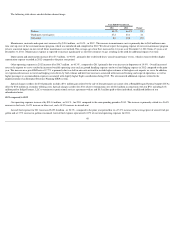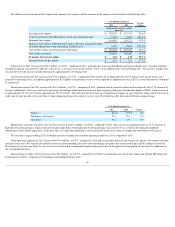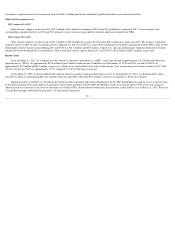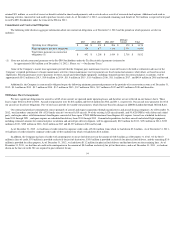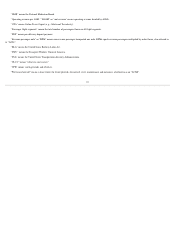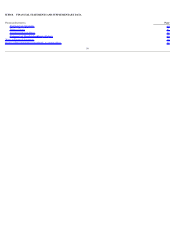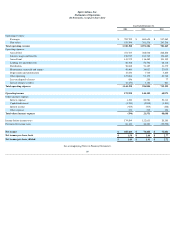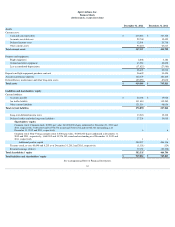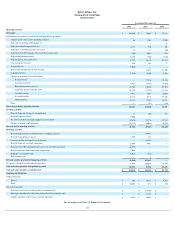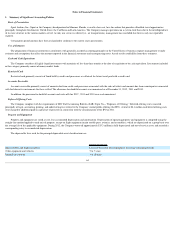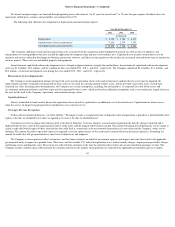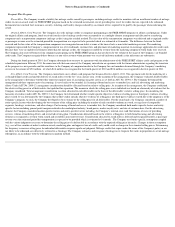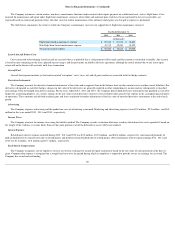Spirit Airlines 2012 Annual Report Download - page 59
Download and view the complete annual report
Please find page 59 of the 2012 Spirit Airlines annual report below. You can navigate through the pages in the report by either clicking on the pages listed below, or by using the keyword search tool below to find specific information within the annual report.
ITEM 7A. QUANTITATIVE AND QUALITATIVE DISCLOSURES ABOUT MARKET RISK
Market Risk-Sensitive Instruments and Positions
We are subject to certain market risks, including commodity prices (specifically aircraft fuel). The adverse effects of changes in these markets could pose a potential
loss as discussed below. The sensitivity analysis provided below does not consider the effects that such adverse changes may have on overall economic activity, nor does it
consider additional actions we may take to mitigate our exposure to such changes. Actual results may differ.
Aircraft Fuel . Our results of operations can vary materially due to changes in the price and availability of aircraft fuel. Aircraft fuel expense for the years ended
December 31, 2012 , 2011 and 2010 represented approximately 41.2% , 41.9% , and 34.8% of our operating expenses. Increases in aircraft fuel prices or a shortage of
supply could have a material adverse effect on our operations and operating results. We source a significant portion of our fuel from refining resources located in the
southeast United States, particularly facilities adjacent to the Gulf of Mexico. Gulf Coast fuel is subject to volatility and supply disruptions, particularly during hurricane
season when refinery shutdowns have occurred, or when the threat of weather related disruptions has caused Gulf Coast fuel prices to spike above other regional sources.
During peak hurricane season (August through October), we may enter into jet fuel swaps to protect the refining price risk between the price of crude oil and the price of
refined jet fuel. In addition to other fuel derivative contracts, we have historically protected approximately 70% of our forecasted fuel requirements during peak hurricane
season using jet fuel swaps. Gulf Coast Jet indexed fuel is the basis for a substantial majority of our fuel consumption. Based on our annual fuel consumption, a 10%
increase in the average price per gallon of aircraft fuel would have increased into-plane aircraft fuel cost for 2012 by approximately 47.2 million . To attempt to manage fuel
price risk, from time to time we use jet fuel option contracts or swap agreements and basis swaps to mitigate a portion of the crack spread between crude and jet fuel. As of
December 31, 2012 , we had fuel hedges using U.S. Gulf Coast jet fuel collars in place for approximately 5% of its 2013 anticipated fuel consumption.
The fair value of our fuel derivative contracts as of December 31, 2012 and 2011 was $0.3 million and $0.3 million net asset (liability), respectively. We measure our
financial derivative instruments at fair value. Fair value of the instruments is determined using standard option valuation models. We measure the fair value of the derivative
instruments based on either quoted market prices or values provided by the counterparty. Changes in the related commodity derivative instrument cash flows may change by
more or less than this amount based upon further fluctuations in futures prices. Outstanding financial derivative instruments expose us to credit loss in the event of
nonperformance by the counterparties to the agreements. However, we do not expect the counterparties to fail to meet their obligations. As of December 31, 2012 , we
believe the credit exposure related to these fuel forward contracts was negligible.
Interest Rates . We have market risk associated with changing interest rates due to LIBOR-based lease rates on five of our aircraft. A hypothetical 10% change in
interest rates in 2012 would affect total aircraft rent expense in 2013 by less than $0.1 million.
58


